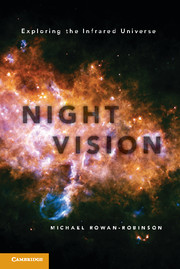Book contents
- Frontmatter
- Contents
- Preface
- 1 Introduction
- 2 William Herschel Opens Up the Invisible Universe
- 3 1800–1950
- 4 Dying Stars Shrouded in Dust and Stars Being Born
- 5 Birth of Submillimetre Astronomy
- 6 The Cosmic Microwave Background, Echo of the Big Bang
- 7 The Infrared Astronomical Satellite and the Opening Up of Extragalactic Infrared Astronomy
- 8 The Cosmic Background Explorer and the Ripples, the Wilkinson Microwave Anisotropy Probe and Dark Energy
- 9 Giant Ground-Based Near-Infrared and Submillimetre Telescopes
- 10 The Infrared Space Observatory and the Spitzer Space Telescope
- 11 Our Solar System’s Dusty Debris Disk and the Search for Exoplanets
- 12 The Future
- Epilogue
- Notes
- Credits for Illustrations
- Glossary
- Further Reading
- Bibliography
- Name Index
- Subject Index
5 - Birth of Submillimetre Astronomy
Clouds of Dust and Molecules in Our Galaxy
Published online by Cambridge University Press: 05 March 2013
- Frontmatter
- Contents
- Preface
- 1 Introduction
- 2 William Herschel Opens Up the Invisible Universe
- 3 1800–1950
- 4 Dying Stars Shrouded in Dust and Stars Being Born
- 5 Birth of Submillimetre Astronomy
- 6 The Cosmic Microwave Background, Echo of the Big Bang
- 7 The Infrared Astronomical Satellite and the Opening Up of Extragalactic Infrared Astronomy
- 8 The Cosmic Background Explorer and the Ripples, the Wilkinson Microwave Anisotropy Probe and Dark Energy
- 9 Giant Ground-Based Near-Infrared and Submillimetre Telescopes
- 10 The Infrared Space Observatory and the Spitzer Space Telescope
- 11 Our Solar System’s Dusty Debris Disk and the Search for Exoplanets
- 12 The Future
- Epilogue
- Notes
- Credits for Illustrations
- Glossary
- Further Reading
- Bibliography
- Name Index
- Subject Index
Summary
We have seen that at near- and mid-infrared wavelengths there are a few wavelength windows accessible from mountaintop observatories, at 1.25, 1.65, 2.2, 3.5, 5, 10 and 20 microns. In the previous chapter, I described the advances that came with pushing out into these near- and mid-infrared windows with ground-based telescopes and with telescopes on rockets. Beyond 20 microns, carbon dioxide and especially water vapour in the Earth’s atmosphere make astronomy from the ground almost impossible until we reach a few submillimetre windows at 350, 450, 850 and 1250 microns (Figure 5.1). In this chapter, I describe how ground-based submillimetre astronomy in these windows developed and how far-infrared and submillimetre astronomy was opened up using aircraft and balloons. The cosmic landscape these wavelengths opened up was one of dense clouds of dust and molecular gas, and of new stars being formed in these clouds.
Submillimetre Astronomy
The father of far-infrared and submillimetre astronomy was undoubtedly Frank Low, who in 1961 had invented the gallium-doped germanium bolometer and the Low dewar. In the previous chapter, I discussed how Low and his collaborators applied this detector to 10- and 20-micron observations of stars and of clouds of cool gas where new stars are forming. In the late 1960s, Frank Low began to work at genuinely far-infrared wavelengths using a 12-inch telescope aboard a Lear executive jet (Figure 5.2). His first attempts at airborne astronomy had begun soon after his move to Arizona in the 1960s, when with Carl Gillespie he observed the Sun at a wavelength of 1 millimetre (1000 microns) from a twin-jet Navy bomber. The Lear jet was an early executive jet, and the telescope was installed in the emergency door opening. The jet flew at 50,000 feet, and the cabin air pressure was so low that the pilots and astronomer operating the telescope needed full breathing equipment. To subtract out the foreground infrared emission from the residual atmosphere, Low installed a tilting secondary mirror operated by a magnetic drive.
- Type
- Chapter
- Information
- Night VisionExploring the Infrared Universe, pp. 59 - 72Publisher: Cambridge University PressPrint publication year: 2013



